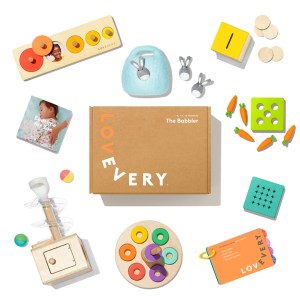A whole new era of pretend play just started

Have you ever seen your toddler put their doll to sleep, walk around in your shoes, stir “soup” in a pot, or bark like a dog? As they approach the 2-year mark, your child is likely starting to play in more creative ways: this is the start of a new era of pretend play.
True imagination play, which involves pretending to be someone or something else, actually happens around age 3 or 4; right now, your toddler’s imagination play is based on their own lived experiences. Your toddler is using their imagination to make sense of the world. The line between reality and fantasy is still blurry, but it’s starting to sharpen with increased real-life experiences and cognitive leaps.
Ways to support your toddler’s pretend play
Imagination often comes naturally, so your role doesn’t have to be demanding. Here are some suggestions:
Make a space for pretend play
Consider making a toddler-proofed imagination zone, like a play tent, a large cardboard box, even a corner in a room with toys and props. Your toddler may not always want to stay there, but it can be a great way to encourage pretend play.
Be clear and descriptive
Because your toddler is starting to learn how to use their imagination in their play, you can help by narrating: “we’re in the car now! You better buckle yourself in” or, “we’re having tea! Can you pour me some?”
Reassure them it’s pretend

At this age, your toddler may get frightened when someone roars like a lion because they don’t know yet that the “lion” is just pretending. You can help by reminding them in clear terms: “Louie is still himself. He is just pretending to be a lion, but he’s still a person”. If your toddler tries to actually eat a toy apple, show them a real one and say “we bite real apples, and pretend to eat play apples”, then show them how to pretend.
Provide easy dress-up clothes

Pants and shirts are still really tricky for toddlers to put on (though you may have noticed they’re a lot easier to take off 😉), so go for simplicity. Wigs, big shoes, capes, robes, and hats—as well as loose fabric and blankets (avoid scarves, which can get wrapped around their necks)—are all relatively easy to put on and take off. Your toddler may not yet be ready to inhabit the role of an imaginary character, but they are starting to pretend to be the people they know.
Give them access to lifelike toys
They don’t have to be exact replicas, but dolls and other toys that look like real things are particularly fun for pretend play. You can use real-world tools from the kitchen or garden as well.
Join in

For your toddler to play for any length of time, you will likely need to be their play partner. If they are pretending to make pancakes, you can say, “can you serve me some of those pancakes on a plate? And pour some syrup on them?”
In this post

The Play Kits
The Play Kits by Lovevery are thoroughly tested, baby safe, eco-friendly and Montessori inspired. Give your child the best start with our stage-based play toy subscription boxes.
Learn moreKeep reading

22 - 24 Months
25 - 27 Months
28 - 30 Months
31 - 33 Months
34 - 36 Months
Our favourite birthday and holiday gift ideas for 2-year-olds
These fun gift ideas for 2-year-olds support their motor skills, independence, and creativity.

19 - 21 Months
22 - 24 Months
25 - 27 Months
28 - 30 Months
31 - 33 Months
34 - 36 Months
What kind of chores are right for my child?
Children as young as 18 months can start taking on regular household responsibilities. These will be simple and straightforward, like wiping up spills or helping set the table, and will require modeling and patience from you.


22 - 24 Months
Welcome to The Companion Play Kit for months 22-24
Watch Lovevery CEO Jessica Rolph introduce the CompanionPlay Kit for months 22 to 24 of your toddler's life.
